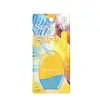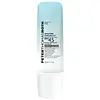What's inside
What's inside
 Key Ingredients
Key Ingredients

 Benefits
Benefits

 Concerns
Concerns

 Ingredients Side-by-side
Ingredients Side-by-side

Water
Skin ConditioningOctocrylene
UV AbsorberHomosalate
Skin ConditioningButyloctyl Salicylate
Skin ConditioningDiethylamino Hydroxybenzoyl Hexyl Benzoate
UV FilterEthylhexyl Salicylate
UV AbsorberPropylene Glycol Dicaprylate/Dicaprate
EmollientAcrylates Crosspolymer
AbsorbentEthylhexyl Triazone
UV AbsorberAcrylates/Dimethicone Copolymer
Skin ConditioningCyclopentasiloxane
EmollientLauryl PEG-9 Polydimethylsiloxyethyl Dimethicone
Skin ConditioningPolymethylsilsesquioxane
Bis-Ethylhexyloxyphenol Methoxyphenyl Triazine
Skin ConditioningCaprylyl Methicone
Skin ConditioningPolysilicone-15
UV FilterButylene Glycol
HumectantPunica Granatum Flower Extract
Skin ConditioningCaprylic/Capric Triglyceride
MaskingSaussurea Involucrata Extract
HumectantParfum
MaskingPentylene Glycol
Skin ConditioningPolyglyceryl-4 Isostearate
EmulsifyingBisabolol
MaskingPhenoxyethanol
PreservativeTocopheryl Acetate
AntioxidantDisodium EDTA
Ascorbyl Palmitate
AntioxidantPanthenol
Skin ConditioningLaminaria Ochroleuca Extract
Skin ConditioningEctoin
Skin ConditioningSodium Hyaluronate
HumectantWater, Octocrylene, Homosalate, Butyloctyl Salicylate, Diethylamino Hydroxybenzoyl Hexyl Benzoate, Ethylhexyl Salicylate, Propylene Glycol Dicaprylate/Dicaprate, Acrylates Crosspolymer, Ethylhexyl Triazone, Acrylates/Dimethicone Copolymer, Cyclopentasiloxane, Lauryl PEG-9 Polydimethylsiloxyethyl Dimethicone, Polymethylsilsesquioxane, Bis-Ethylhexyloxyphenol Methoxyphenyl Triazine, Caprylyl Methicone, Polysilicone-15, Butylene Glycol, Punica Granatum Flower Extract, Caprylic/Capric Triglyceride, Saussurea Involucrata Extract, Parfum, Pentylene Glycol, Polyglyceryl-4 Isostearate, Bisabolol, Phenoxyethanol, Tocopheryl Acetate, Disodium EDTA, Ascorbyl Palmitate, Panthenol, Laminaria Ochroleuca Extract, Ectoin, Sodium Hyaluronate
Butyl Methoxydibenzoylmethane 3%
UV AbsorberHomosalate 5%
Skin ConditioningEthylhexyl Salicylate 5%
UV AbsorberOctocrylene 10%
UV AbsorberWater
Skin ConditioningPolymethylsilsesquioxane
Glycerin
HumectantDipropylene Glycol
HumectantDimethicone
EmollientArgania Spinosa Kernel Oil
EmollientTocopheryl Acetate
AntioxidantYeast Extract
Skin ConditioningCyclopentasiloxane
EmollientCyclohexasiloxane
EmollientPhenoxyethanol
PreservativeLauryl PEG-9 Polydimethylsiloxyethyl Dimethicone
Skin ConditioningIsododecane
EmollientDimethicone/PEG-10/15 Crosspolymer
Saccharide Isomerate
HumectantMethyl Gluceth-20
HumectantSodium Chloride
MaskingSodium Hyaluronate
HumectantBisabolol
MaskingPEG-15/Lauryl Dimethicone Crosspolymer
StabilisingSodium PCA
HumectantPropylene Glycol
HumectantCeteareth-25
CleansingSodium Benzoate
MaskingPotassium Sorbate
PreservativeSodium Citrate
BufferingCitric Acid
BufferingSambucus Nigra Fruit Extract
AstringentCetyl Alcohol
EmollientSaccharomyces/Magnesium Ferment
Hydrolyzed Silk
HumectantBehenic Acid
CleansingCeramide NP
Skin ConditioningCholesterol
EmollientEthylhexylglycerin
Skin ConditioningTocopherol
AntioxidantCeramide Ns
Skin ConditioningSaccharomyces/Iron Ferment
Skin ConditioningSaccharomyces/Copper Ferment
Skin ConditioningSaccharomyces/Silicon Ferment
Skin ConditioningSaccharomyces/Zinc Ferment
Skin ConditioningButylene Glycol
HumectantCeramide AP
Skin ConditioningCeramide EOP
Skin ConditioningCeramide Eos
Skin ConditioningOlea Europaea Leaf Extract
PerfumingCaprooyl Phytosphingosine
Skin ConditioningCaprooyl Sphingosine
Skin ConditioningDisodium EDTA
Ascorbyl Palmitate
AntioxidantMica
Cosmetic ColorantButyl Methoxydibenzoylmethane 3%, Homosalate 5%, Ethylhexyl Salicylate 5%, Octocrylene 10%, Water, Polymethylsilsesquioxane, Glycerin, Dipropylene Glycol, Dimethicone, Argania Spinosa Kernel Oil, Tocopheryl Acetate, Yeast Extract, Cyclopentasiloxane, Cyclohexasiloxane, Phenoxyethanol, Lauryl PEG-9 Polydimethylsiloxyethyl Dimethicone, Isododecane, Dimethicone/PEG-10/15 Crosspolymer, Saccharide Isomerate, Methyl Gluceth-20, Sodium Chloride, Sodium Hyaluronate, Bisabolol, PEG-15/Lauryl Dimethicone Crosspolymer, Sodium PCA, Propylene Glycol, Ceteareth-25, Sodium Benzoate, Potassium Sorbate, Sodium Citrate, Citric Acid, Sambucus Nigra Fruit Extract, Cetyl Alcohol, Saccharomyces/Magnesium Ferment, Hydrolyzed Silk, Behenic Acid, Ceramide NP, Cholesterol, Ethylhexylglycerin, Tocopherol, Ceramide Ns, Saccharomyces/Iron Ferment, Saccharomyces/Copper Ferment, Saccharomyces/Silicon Ferment, Saccharomyces/Zinc Ferment, Butylene Glycol, Ceramide AP, Ceramide EOP, Ceramide Eos, Olea Europaea Leaf Extract, Caprooyl Phytosphingosine, Caprooyl Sphingosine, Disodium EDTA, Ascorbyl Palmitate, Mica
 Reviews
Reviews

Ingredients Explained
These ingredients are found in both products.
Ingredients higher up in an ingredient list are typically present in a larger amount.
Ascorbyl Palmitate is created by combining pure Vitamin C and palmitic acid. It is an antioxidant and helps reduce hyperpigmentation.
This ingredient is a more stable version of Vitamin C, meaning it does not disintegrate as quickly when exposed to sunlight. However, studies show it does not penetrate skin as well as pure Vitamin C.
Ascorbyl Palmitate is oil soluble.
Read more about other types of Vitamin C:
Learn more about Ascorbyl PalmitateBisabolol is famous for its skin soothing properties. It does this by blocking inflammatory signals, helping to reduce your body's reaction to irritation.
This ingredient also interferes with the process of hyperpigmentation. This can help with reducing dark spots and uneven tone.
Bisabolol is an antioxidant. Antioxidants help fight free-radicals. Free-radicals are molecules that may damage your skin cells. By fighting these free-radicals, Bisabolol may slow down signs of aging.
Studies have shown Bisabolol to have antimicrobial properties and may be a fungicide. These properties help preserve a product's shelf life.
All these properties makes bisabolol a great skin barrier helper ingredient.
Bisabolol also helps the absorption of other ingredients.
Note: Synthetic Bisabolol has been shown to be less effective.
Learn more about BisabololButylene Glycol (or BG) is used within cosmetic products for a few different reasons:
Overall, Butylene Glycol is a safe and well-rounded ingredient that works well with other ingredients.
Though this ingredient works well with most skin types, some people with sensitive skin may experience a reaction such as allergic rashes, closed comedones, or itchiness.
Learn more about Butylene GlycolCyclopentasiloxane, or D5, is a silicone used to improve texture of products and trap moisture.
D5 is considered lightweight and volatile. Volatile means it evaporates quickly after application. Once evaporated, D5 leaves a thin barrier that helps keep skin hydrated.
It is also an emollient. Emollients help soften the skin and prevent water loss. Silicones create a silky texture in products. D5 helps other ingredients become more spreadable.
Studies show D5 is safe to use in skincare products. We recommend speaking with a skincare professional if you have concerns.
Learn more about CyclopentasiloxaneDisodium EDTA plays a role in making products more stable by aiding other preservatives.
It is a chelating agent, meaning it neutralizes metal ions that may be found in a product.
Disodium EDTA is a salt of edetic acid and is found to be safe in cosmetic ingredients.
Learn more about Disodium EDTAEthylhexyl Salicylate is an organic compound used to block UV rays. It primarily absorbs UVB rays but offers a small amount of UVA protection as well.
Commonly found in sunscreens, Ethylhexyl Salicylate is created from salicylic acid and 2-ethylhexanol. You might know salicylic acid as the effective acne fighter ingredient and BHA.
The ethylhexanol in this ingredient is a fatty alcohol and helps hydrate your skin, similar to oils. It is an emollient, which means it traps moisture into the skin.
According to manufacturers, Ethylhexyl Salicylate absorbs UV wavelength of 295-315 nm, with a peak absorption at 307-310 nm. UVA rays are linked to long term skin damage, such as hyperpigmentation. UVB rays emit more energy and are capable of damaging our DNA. UVB rays cause sunburn.
Learn more about Ethylhexyl SalicylateHomosalate is a chemical sunscreen filter that provides protection in the UV-B range (280nm - 320 nm), with a peak protection at 306 nm. It is internationally approved for use in sunscreens.
Homosalate is not photo-stable, meaning it's strength as a UV filter degrades over time with exposure to the sun. Because of this, it's often used in combination with other chemical sunscreen filters as avobenzone (which protects from the UV-A range). Homosalate also helps act as a solvent for harder-to-dissolve UV filters.
(Part of the reason that sunscreens need to be frequently re-applied is due to the photo instability of many chemical sunscreen filters)
Currently, homosalate is approved in concentrations up to 10% in the EU and 15% in the US. The FDA is currently doing further research on the effects of homosalate, and it is possible that these approved concentrations will change in the future.
Learn more about HomosalateLauryl PEG-9 Polydimethylsiloxyethyl Dimethicone is a type of silicone.
Octocrylene protects skin from sun damage. It absorbs UV-B with peak absorption of 304 nm. It is a common sunscreen ingredient and often paired with avobenzone, a UVA filter. This is because octocrylene stabilizes other sunscreen ingredients by protecting them from degradation when exposed to sunlight. Octocrylene is a photostable ingredient and loses about 10% of SPF in 95 minutes.
Octocrylene also acts as an emollient, meaning it helps skin retain moisture and softens skin. It is oil-soluble and hydrophobic, enhancing water-resistant properties in a product.
Those who are using ketoprofen, a topical anti-inflammatory drug, may experience an allergic reaction when using octocrylene. It is best to speak with a healthcare professional about using sunscreens with octocrylene.
The EU allows a maximum of these concentrations:
Learn more about OctocrylenePhenoxyethanol is a preservative that has germicide, antimicrobial, and aromatic properties. Studies show that phenoxyethanol can prevent microbial growth. By itself, it has a scent that is similar to that of a rose.
It's often used in formulations along with Caprylyl Glycol to preserve the shelf life of products.
Polymethylsilsesquioxane is a silicone used as a film forming agent.
When applied to the skin, this ingredient creates an invisible film on the surface. This film still allows oxygen to pass through, but prevents moisture from escaping. This can help condition and hydrate the skin. It also leaves a silky feel when applied.
Polymethylsilsesquioxane has not been shown to clog pores. It has been deemed safe to use up to 55%, but most cosmetics use much less.
If you have concerns about using this ingredient, we recommend speaking with a professional.
Learn more about PolymethylsilsesquioxaneSodium Hyaluronate is hyaluronic acid's salt form. It is commonly derived from the sodium salt of hyaluronic acid.
Like hyaluronic acid, it is great at holding water and acts as a humectant. This makes it a great skin hydrating ingredient.
Sodium Hyaluronate is naturally occurring in our bodies and is mostly found in eye fluid and joints.
These are some other common types of Hyaluronic Acid:
Learn more about Sodium HyaluronateTocopheryl Acetate is AKA Vitamin E. It is an antioxidant and protects your skin from free radicals. Free radicals damage the skin by breaking down collagen.
One study found using Tocopheryl Acetate with Vitamin C decreased the number of sunburned cells.
Tocopheryl Acetate is commonly found in both skincare and dietary supplements.
Learn more about Tocopheryl AcetateWater. It's the most common cosmetic ingredient of all. You'll usually see it at the top of ingredient lists, meaning that it makes up the largest part of the product.
So why is it so popular? Water most often acts as a solvent - this means that it helps dissolve other ingredients into the formulation.
You'll also recognize water as that liquid we all need to stay alive. If you see this, drink a glass of water. Stay hydrated!
Learn more about Water